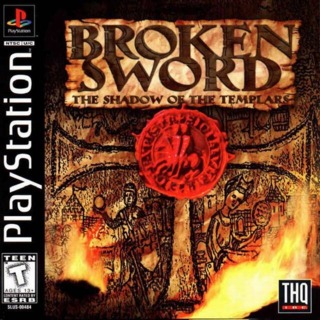Broken Sword, while a classic adventure game, did not live up to the expectation created by its reputation.
According to GameSpot's rating, Broken Sword is the third best adventure game of all time. While we cannot agree with the rating, Broken Sword is a solid adventure game with a reasonable, if not immersive, plot. Strangely all of GameSpot's Top 10 adventure games of all time were released before 2002 and indeed only three after 2000. It seems that adventure gaming, as a genre, hit its peak before 3D engines, with mesmerizing graphics arrived, with the most popular genres now being shooters and RTS. Of the limited adventure games we have played, only a few have been 3D with a first person point of view with most being played from a 3rd person perspective and point and click. Perhaps adventure games, in the traditional point and click sense, are no longer tenable when action adventure games, especially open world ones like Saboteur or Assassin's Creed, are being released.
Broken Sword finds our unwitting (or witless) protagonist, George, involved in a conspiracy that involves the Knights Templar and supernatural forces and stretches to the highest levels. The story largely takes place in Paris with trips to Ireland, Syria and Scotland, where the grand finale takes place.
While containing plot elements of Umberto Eco's Foucault's Pendulum, and to a much lesser degree Dan Brown's Da Vinci Code, Broken Sword failed to be as immersive as these novels. Perhaps it is the cartoonish presentation or the corny humour or lighthearted tone or indeed George, the protagonist, but we failed to engage with the game as we had with either of the two Holme's adventures or Syberia played previously. Alas it is the narrative of an adventure game, and how it is progressed through the solution of various puzzles, together with the characters that makes an adventure game work. Broken Sword all these elements but the narrative itself, despite the odd twist, was somewhat predictable and the main character, George, eventually becomes quite tiresome, much like the stereotypical obnoxious American tourist he portrays.
In fact the game is full of stereotypical characters, be they French policemen, moustache twirling villains, Irish pub denizens, Spanish gardeners or Syrian merchants. That said, much of the humour, which we suspect is by design rather than default, derives from the stereotypical behaviour of the characters. In fact it is the diverse array of non-player characters, and what they say, that lifted this game in our view, given the predictability of the plot. Alas the same cannot be said of George, the playable character. One needs to feel some connection with the character one is playing irrespective of race, colour or creed, alas we could not connect with poor vague George. We could not work out why Nico might be attracted to him; Indiana Jones he is not.
That said there is a lot to like about Broken Sword but you need to be prepared to be in more of a Clouseau comedic mood than that of a magnifying glass wielding Holmes. While the narrative is at times predictable the puzzles are sufficiently challenging, if at times obtuse, and the story moves along at a brisk pace. What sets Broken Sword apart from the other games adventure games we have played was the dialogue, which was both witty and humourous, if perhaps inappropriate to the serious nature of the narrative.
Broken Sword is a typical 3rd person point and click adventure in a 2D environment. The graphics are of course dated, and while not up to the graphical standard of, say Syberia, this in no way detracts from the enjoyment of the game. The "off screen" user interface containing your inventory and dialogue icons looks somewhat archaic but is very easy to use. The closest example of the look of the game I can think of is the Ralph Bakshi animated Lord of the Rings movie (1978). Sadly the cut-scenes look somewhat blurry (given the game's big pixel DOS-era origins) at maximum resolution but are nevertheless well presented. Character animations in-game look a bit robotic but again it is a 1996 game.
Where the game did not quite work for us was its tone. Convoluted conspiracies involving the Knights Templar perhaps need a more serious tone like that in Sherlock Holmes: The Awakened. While we eventually succumbed to the humour we felt the narrative, whether predictable or not, needed a more serious approach but then the look of the characters and indeed 2D environments would have needed a change as well. So I guess one could say that Broken Sword is a tongue in cheek mystery adventure game.
A warning to regular point and click adventure gamers: unlike other adventure games your character George can die if he makes the wrong choices, thus ending the game, so make sure you save your progress regularly.
OVERALL: While our experience of Broken Sword did not live up to the expectation we had given its high regard in adventure gaming circles, it is a solid game with reasonable challenges and a touch of humour. Indeed Broken Sword is somewhat of a classic and on that basis alone is worth a play through.

